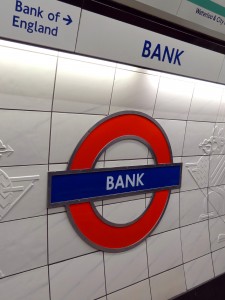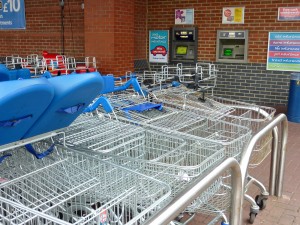 On 2 May 2012, Sir Mervyn King, Governor of the Bank of England, gave the BBC Today Prgramme’s public lecture. In it, he reflected on the causes and aftermath of the banking crisis of 2007/8.
On 2 May 2012, Sir Mervyn King, Governor of the Bank of England, gave the BBC Today Prgramme’s public lecture. In it, he reflected on the causes and aftermath of the banking crisis of 2007/8.
He said that the main cause of the banking crisis was the risky behaviour of the banks themselves – behaviour that they had been allowed to get away with becuase regulation was too light. The cause was not one of inappropriate fiscal and monetary policy.
According to Dr King, there had been no classical macroeconomic boom and bust. True there had been a bust, but there was no preceding boom. Economic growth had not been unsustainable in the sense of being persistently above the potential rate. In other words, the output gap had been close to zero. As Mervyn King puts it
Let me start by pointing out what did not go wrong. In the five years before the onset of the crisis, across the industrialised world growth was steady and both unemployment and inflation were low and stable. Whether in this country, the United States or Europe, there was no unsustainable boom like that seen in the 1980s; this was a bust without a boom.
In terms of monetary policy, inflation had been on track and interest rates were not too low. And as for fiscal policy, government borrowing had been within the Golden Rule, whereby, over the cycle, the goverment borrowed only to invest and kept a current budget balance. Indeed, the period of the late 1990s and early to mid 2000s had become known as the Great Moderation.
So what went wrong? Again in the words of Dr King:
In a nutshell, our banking and financial system overextended itself. That left it fragile and vulnerable to a sudden loss of confidence.
The most obvious symptom was that banks were lending too much. Strikingly, most of that increase in lending wasn’t to families or businesses, but to other parts of the financial system. To finance this, banks were borrowing large amounts themselves. And this was their Achilles’ heel. By the end of 2006, some banks had borrowed as much as £50 for every pound provided by their own shareholders. So even a small piece of bad news about the value of its assets would wipe out much of a bank’s capital, and leave depositors scurrying for the door. What made the situation worse was that the fortunes of banks had become closely tied together through transactions in complex and obscure financial instruments. So it was difficult to know which banks were safe and which weren’t. The result was an increasingly fragile banking system.
But doesn’t his imply that regulation of the banking system had failed? And if so why? And have things now been fixed – so that banks will no longer run the risk of failure? Dr King addresses this issue and others in his speech and also in his interview the next day for the Today Programme, also linked to below.
Podcasts
The Today Programme Lecture BBC Radio 4, Sir Mervyn King (2/5/12) (Transcript of speech)
Also on YouTube at Governor’s Today Programme lecture, 2 May 2012
Sir Mervyn King: The full interview BBC Today Programme, Sir Mervyn King talks to Evan Davis (3/5/12)
Sir Mervyn King analysis ‘verging on delusional’ BBC Today Programme, Dylan Grice and Ngaire Woods (3/5/12)
Articles
Sir Mervyn King rejects criticism for crisis BBC News (3/5/12)
The boom and bust of Mervyn King BBC News, Robert Peston (3/5/12)
Sir Mervyn King admits BoE failed over financial crisis The Telegraph, Philip Aldrick (3/5/12)
Sir Mervyn King admits: we did too little to warn of economic crisis Guardian, Larry Elliott (2/5/12)
King Says BOE Will Risk Unpopularity to Prevent Crises Bloomberg, Jennifer Ryan and Scott Hamilton (3/5/12)
Data
Economic Outlook Annex Tables OECD (See Annex Tables 1, 10, 14, 18, 27, 28, 32, 33, 61 and 62)
Statistical Interactive Database Bank of England (See for example, A Money and Lending: counterparts to changes in M4, alternative presentation > Seasonally adjusted > Public sector contribution > PSNCR)
Questions
- Why was the period of the late 1990s and early to mid 2000s described as the Great Moderation?
- Chart the size of the output gap, the rate of inflation and public-sector deficits as a percentage of GDP in the UK and other major economies from 1995 to 2007. Is this evidence of the Great Moderation?
- To what extent would evidence of house prices, consumer debt, bank lending and the balance of trade deficit suggest that there was indeed a boom from the mid 1990s to 2007?
- What, according to Dr King were the main causes of the credit crunch?
- What, with hindsight, should the Bank of England have done differently?
- What UK body was responsible for regulating banks in the run up to the credit crunch? Why might its regulation be described as ‘light touch’?
- In what sense was there a moral hazard in central banks being willing to bail out banks?
- What banking reforms have taken place or will take place in the near future? Will they address the problems identified by Dr King and prevent another banking crisis ever occurring again?
 Australia was one of the few economies that seemed to be somewhat insulated from the 2008/09 recession and credit crunch. However, with the UK now back in recession and global economic conditions worsening in much of Europe, Australia has now joined the list of countries that are experiencing economic conditions that are ‘weaker than forecast’.
Australia was one of the few economies that seemed to be somewhat insulated from the 2008/09 recession and credit crunch. However, with the UK now back in recession and global economic conditions worsening in much of Europe, Australia has now joined the list of countries that are experiencing economic conditions that are ‘weaker than forecast’.
Today’s world involves economies that are increasingly interdependent, hence the spread of the world economic slowdown. As such, with weak global demand, Australia has started to feel the effects, with demand for its goods and raw materials falling. This has led Australia’s central bank – the Reserve Bank of Australia – to cut its key interest rate (the ‘cash rate’) by more than expected. The rate had been at 4.25% and it was widely believed that a 0.25 percentage point cut would occur. However, the central bank cut the cash rate rate to 3.75% to counter the weakening conditions. The Reserve Bank said:
“This decision is based on information received over the past few months that suggests that economic conditions have been somewhat weaker than expected, while inflation has moderated …Growth in the world economy slowed in the second half of 2011, and is likely to continue at a below-trend pace this year.”
Banks’ interest rates have been falling in Australia for the past few months and this latest cut will do much to help financially squeezed households. Data show that Australian house sales have fallen, as have house prices, and retail sales have fared little better.
Lower interest rates are often a tool used to steer inflation and the Australian central bank may not have been as willing to cut rates had the inflation rate not come down in recent months. Keeping consumer prices under control remains a top priority for the central bank and so it will be interesting to see the impact that these rate cuts will have on the Australian economy.
Articles
Australia cenbank surprises with aggressive half point rate cut Reuters, Wayne Cole (1/5/12)
Australia cuts rates by than forecast to 3.75% BBC News (1/5/12)
Banks unlikely to pass on full rate cut The Australian, Wall Street Journal, Peter Trute (1/5/12)
Australia cuts rate to support economy Financial Times, Neil Hume (1/5/12)
Australia slashes interest rates by 0.5pc to boost economy The Telegraph (1/5/12)
Australia cuts interest rates as economy slows Guardian, Phillip Inman (1/5/12)
Banks must pass on rate cut: businesses Sydney Morning Herald, Ehssan Veiszadeh (1/5/12)
Bond prices rally after rate cut Sydney Morning Herald (1/5/12)
Surplus remains appropriate: Swan Sydney Morning Herald, Colin Brinsden (1/5/12)
Webcasts
 Reserve Bank of Australia Cuts Rates by 50 Basis Points to 3.75% CNBC video, Lauren Rosborough (1/5/12)
Reserve Bank of Australia Cuts Rates by 50 Basis Points to 3.75% CNBC video, Lauren Rosborough (1/5/12)
 Further `Modest’ RBA Easing Possible, ANZ Says Bloomberg, Tony Morriss (1/5/12)
Further `Modest’ RBA Easing Possible, ANZ Says Bloomberg, Tony Morriss (1/5/12)
 Australia’s central bank shifts focus to growth BBC News, Duncan Kennedy (1/5/12)
Australia’s central bank shifts focus to growth BBC News, Duncan Kennedy (1/5/12)
Questions
- Which factors will a central bank consider when setting interest rates?
- Explain the components of aggregate demand that will be affected by a lower rate of interest.
- Using diagrams to illustrate the process, explain both the interest-rate and the exchange-rate transmission mechanisms of the fall in interest rates.
- How are interest rates used to target inflation?
- How will lower rates of interest help the Australian economy recover from weakening global economic conditions?
- Why are Australia’s banks unlikely to pass on the full rate cut to consumers?
- Why did bond prices rise and the Australian dollar depreciate after the rate cut? Why does this suggest that a 0.5% cut was greater than anticpated by markets?
 Oligopoly: it’s a complex market structure and although closer to the monopoly end of the ‘Market Structure Spectrum’, it can still be a highly competitive market. The characteristics are well-documented and key to the degree of competition within any oligopoly is the number of competitors and extent to which there are barriers to entry.
Oligopoly: it’s a complex market structure and although closer to the monopoly end of the ‘Market Structure Spectrum’, it can still be a highly competitive market. The characteristics are well-documented and key to the degree of competition within any oligopoly is the number of competitors and extent to which there are barriers to entry.
The greater the barriers and the fewer the competitors the greater the power the established firms have. This can then spell trouble for pricing and hence for consumers. The following articles are just some examples of the oligopolies that exist around the world and some of the benefits and problems that accompany them.
Articles
Oligopoly of PSU oil cos reason for high ATF prices The Indian Express, Smita Aggarwal (30/4/12)
Group energy buying hits the UK headlines Spend Matters UK/Europe(18/1/11)
German cartel office probes petrol companies on pricing Fox Business (4/4/12)
Gov’t unveils steps to lower fuel prices Yonhap News (19/4/12)
How big banks threaten our economy Wall Street Journal, Warren Stephens (29/4/12)
UK Governance: Call for Whitehall to simplify the landscape for SME suppliers to win more government contracts The Information Daily (26/4/12)
Other blogs
Pumping up the price: fuel cartels in Germany April 2012
Energy profit margins up by over 700% October 2011
Every basket helps October 2011
The art of oligopoly December 2010
Questions
- What are the assumptions of an oligopolistic market structure?
- Consider (a) the energy sector and (b) the banking sector. To what extent does each market conform with the assumptions of an oligopoly?
- In the ‘Spend Matters’ article, a group of people in a Lincolnshire village formed a local buying consortium to negotiate deals for heating oil. What could we refer to this as?
- To what extent is an oligopoly in the public interest?
- Explain how barriers to entry in oligopolies affect the competitiveness and efficiency of a market.
- Illustrate how an oligopolistic market structure can fix prices and hence exploit consumers.
- How have the actions of the big oil companies in both the UK and Germany been against independent retailers and the consumer interest?
- What action can governments take to break up oligopolies? Will it always be effective?
 The UK is officially back in recession: or to be more accurate, a double-dip recession.
The UK is officially back in recession: or to be more accurate, a double-dip recession.
The generally accepted definition of a recession is two or more quarters of negative growth in real GDP. According to figures released by the Office for National Statistics, the UK economy shrank by 0.2% in quarter 1, 2012, having shrunk by 0.3% in quarter 4, 2011.
(Click on the following link for a PowerPoint of the above chart: Double dip 2)
As you can see from the chart (click chart for a larger version), these declines are tiny compared with the recession of 2008/9. Nevertheless, with the eurozone economy slowing (Britain’s largest export market), and with cuts to government expenditure set to bite harder in the coming months, there are worries that there may be more quarters of negative growth to come.
So what are the causes of this double-dip recession? Are they largely external, in terms of flagging export markets; or are they internal? Is the new recession the direct result of the tight fiscal policy pursued by the Coalition government?
And what is to be done? Is there no option but to continue with the present policy – the government’s line? Or should the austerity measures be reined in? After all, as we saw in the last blog post (Economic stimulus, ‘oui’; austerity, ‘non’), the mood in many European countries is turning against austerity.
The following articles explore the causes and policy implications of the latest piece of bad news on the UK economy.
Articles
Double-dip recession a terrible blow for George Osborne Guardian, Larry Elliott (25/4/12)
Double-dip recession figures mark another bad day for George Osborne Guardian, Larry Elliott (25/4/12)
UK double-dip recession: what the economists say Guardian (25/4/12)
Feared double dip recession becomes reality as British economy contracts again in first quarter of 2012 Daily Record (25/4/12)
Britain in double-dip recession as growth falls 0.2pc The Telegraph, Angela Monaghan and Szu Ping Chan (25/4/12)
Did the eurozone crisis cause the double-dip recession? Guardian, Polly Curtis (25/4/12)
UK’s double-dip recession Financial Times, Chris Giles (25/4/12)
UK is in ‘double dip’ recession FT Adviser, Rebecca Clancy and John Kenchington (25/4/12)
 Flanders explains GDP figure BBC News, Stephanie Flanders (25/4/12)
Flanders explains GDP figure BBC News, Stephanie Flanders (25/4/12)
No recovery for UK: No let up for ONS BBC News, Stephanie Flanders (25/4/12)
Double-dip recession: There’s always fantasy island BBC News, Paul Mason (25/4/12)
UK double-dip recession to drag on into summer, economists warn The Telegraph, Philip Aldrick (26/4/12)
George Osborne can stop the rot, but only by spending as he slashes The Telegraph, Jeremy Warner (25/4/12)
Double dip has arrived – and Osborne is running out of escape routes Independent, Ben Chu (26/4/12)
Britain’s bosses tell the ONS: it’s bad, but not a recession Independent, Tom Bawden, Lucy Tobin , Gideon Spanier (26/4/12)
The Chancellor received plenty of warning Independent, David Blanchflower (26/5/12)
Data
Gross Domestic Product: Preliminary Estimate, Q1 2012 ONS (25/4/12)
Preliminary Estimate of GDP Time Series Dataset 2012 Q ONS (25/4/12)
World Economic Outlook Database IMF (17/4/12)
Business and Consumer Surveys (for all individual EU countries and for the EU as a whole) European Commission: Economic and Financial Affairs
Consumer Confidence Nationwide Building Society
Questions
- Assess the current state of the UK economy and its likely course over the coming few months.
- Why may looking at the business surveys provide a truer picture of the state of the UK economy than the official measure of GDP?
- Why has the UK economy gone back into recession?
- Compare the policy approaches of the Coalition government with those of the Labour opposition.
- How important is it for the UK to retain its AAA credit rating?
 A crucial determinant of the economy’s short-term prospects is the appetite of households for spending. This is because household spending makes up roughly two-thirds of the total demand for firms’ goods and services or two-thirds of what economists refer to as aggregate demand. So what are the latest forecasts for consumer spending? We briefly consider the forecasts of the Office for Budget Responsibility for consumer spending and, in doing so, update an earlier bog Gloomy prospects for spending in 2012?
A crucial determinant of the economy’s short-term prospects is the appetite of households for spending. This is because household spending makes up roughly two-thirds of the total demand for firms’ goods and services or two-thirds of what economists refer to as aggregate demand. So what are the latest forecasts for consumer spending? We briefly consider the forecasts of the Office for Budget Responsibility for consumer spending and, in doing so, update an earlier bog Gloomy prospects for spending in 2012?
In its March 2012 Economic and Fiscal Outlook the Office for Budget Responsibility presents it forecasts for economic growth and household spending. The following table summarises these forecasts.
OBR Forecasts (annual real percentage change)
|
2012 |
2013 |
2014 |
2015 |
2016 |
| GDP |
0.8 |
2.0 |
2.7 |
3.0 |
3.0 |
| Consumption |
0.5 |
1.3 |
2.3 |
3.0 |
3.0 |
| Disposable income |
–0.2 |
0.5 |
1.9 |
2.4 |
2.5 |
 On 2 May 2012, Sir Mervyn King, Governor of the Bank of England, gave the BBC Today Prgramme’s public lecture. In it, he reflected on the causes and aftermath of the banking crisis of 2007/8.
On 2 May 2012, Sir Mervyn King, Governor of the Bank of England, gave the BBC Today Prgramme’s public lecture. In it, he reflected on the causes and aftermath of the banking crisis of 2007/8.



